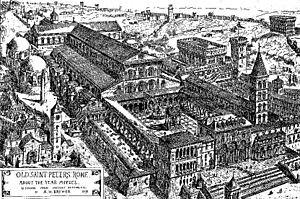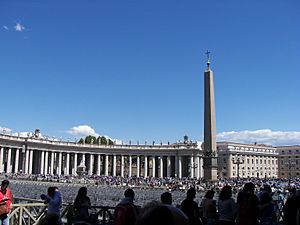St. Peter's Square facts for kids
St. Peter's Square is a very large open space right in front of St. Peter's Basilica in Vatican City. Vatican City is a tiny country located inside Rome, Italy. Both the square and the church are named after Saint Peter, who was one of Jesus's main followers and is seen by Catholics as the first Pope.
In the middle of the square stands an ancient obelisk from ancient Egypt. It was put there in 1586. About 100 years later, a famous artist named Gian Lorenzo Bernini designed the square. He added the huge stone columns, called colonnades, which look like they are giving visitors a big hug, like "the maternal arms of Mother Church." There are also two large granite fountains in the square. One was built by Bernini in 1675, and the other by Carlo Maderno in 1613.
Contents
History of St. Peter's Square
The large open area in front of St. Peter's Basilica was redesigned by Gian Lorenzo Bernini between 1656 and 1667. This project was led by Pope Alexander VII. The main goal was to create a grand entrance where many people could see the Pope give his blessings.
Bernini had already worked on the inside of St. Peter's for many years. For the square, he used a simple style of columns, called Doric order, so they wouldn't take attention away from the church's front, which was designed by Carlo Maderno. However, Bernini made these columns very large to fit the space and make people feel amazed.
Bernini faced some challenges because of buildings that were already there. The Vatican Palace was on the right side of the church, and its buildings were very close to the square. Bernini needed to hide these buildings without blocking the Pope's living areas. Also, the tall obelisk was already in the center, and a granite fountain by Maderno was on one side. Bernini made the fountain a key part of his design and later added a matching fountain on the other side in 1675.
The square has a special trapezoid shape, which makes it look even bigger and more dramatic as you leave the church. This shape was mostly created because of the existing buildings and space.
Even though St. Peter's Square is part of the Vatican country, the Italian police are in charge of managing crowds there. This agreement was made in the Lateran Treaty.
The Colonnades: Bernini's Design
The massive Doric columns, arranged four deep, create a frame around the entrance to the basilica and the large oval area in front of it. This oval shape, which is wider than it is long, makes you pause before moving towards the church. The colonnades truly define the square. Bernini said the oval center of the square, with its columns, wraps around visitors like "the maternal arms of Mother Church."
On the south side, the columns create a clear boundary, with the beautiful Barberini Gardens rising behind them. On the north side, the colonnade hides various Vatican buildings, with the upper parts of the Vatican Palace visible above.
The Ancient Obelisk
At the very center of the oval part of the square stands an Egyptian obelisk. It's made of red granite and is about 25.5 meters (84 feet) tall. It rests on bronze lions and has the Chigi family's symbol in bronze at the top. Including the cross on top, it reaches about 41 meters (135 feet) high. This obelisk was first built in Heliopolis, Egypt, by an unknown pharaoh.
The Roman Emperor Augustus had the obelisk moved to Alexandria, Egypt, where it stayed until AD 37. Then, Emperor Caligula ordered it moved to Rome and placed in the middle of the Circus of Nero, a large stadium for chariot races.
In 1586, the engineer Domenico Fontana moved the obelisk to its current spot under the direction of Pope Sixtus V. Moving such a huge, heavy stone was a major engineering feat! The Vatican Obelisk is special because it's the only obelisk in Rome that has never fallen over since ancient Roman times.
During the Middle Ages, people believed that a golden ball on top of the obelisk held the ashes of Julius Caesar. Fontana later removed this old metal ball (which is now in a Rome museum) and found only dust inside. Even though Bernini didn't help put the obelisk up, he used it as the main focus of his amazing square. He added the Chigi family's symbol to the top to honor his patron, Pope Alexander VII.
The Paving and Sundial
The ground of the square is paved with cobblestones, but it has lines made of travertine stone that spread out from the center. This helps break up the large space. In 1817, round stones were placed to show where the tip of the obelisk's shadow would fall at noon on different days of the year, as the sun entered each of the zodiac signs. This turned the obelisk into a giant sundial!
Below is a view of St. Peter's Square from the top of the church's dome, taken in June 2007.
The Via della Conciliazione
Today, you can reach St. Peter's Square by walking along a grand road called the Via della Conciliazione. This road was built to celebrate the Lateran Treaty of 1929.
Before this road, there was a narrow section of buildings called the spina that divided two old streets leading to the square. This spina was torn down by Benito Mussolini himself on October 23, 1936, and completely removed by October 8, 1937. After this, St. Peter's Basilica could be seen clearly from the Castel Sant'Angelo, an old fortress.
The demolition of the spina also meant that many old medieval and Renaissance buildings south of the Passetto di Borgo (a secret passage) were destroyed between 1937 and 1950. This change also removed the "surprise" feeling that visitors used to get when they suddenly saw the grand square after walking through narrow streets. The Via della Conciliazione was finished just in time for the Great Jubilee (a special Catholic event) in 1950.
Images for kids
-
St. Peter's Square by Viviano Codazzi, 1630
-
Bernini's fountain, 1675
-
Obelisk with a Christmas tree
See also
 In Spanish: Plaza de San Pedro para niños
In Spanish: Plaza de San Pedro para niños

















